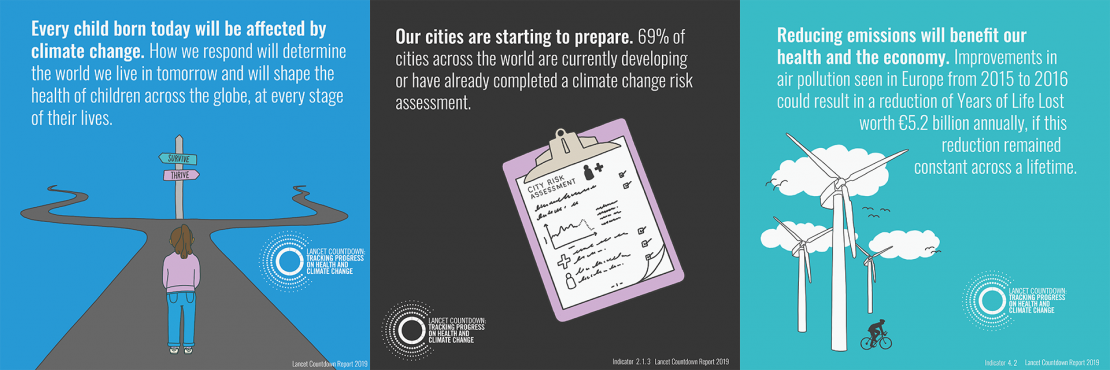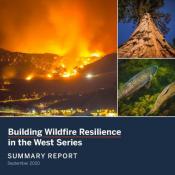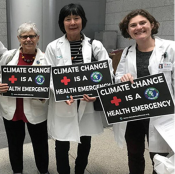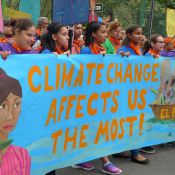Philanthropy to address climate change and its health and equity impacts is a landscape of growing need and opportunity. For some funders, this is a direct area of focus. For others, it is an important dimension of existing work focused on places, populations, or issues. Understanding the varied ways in which philanthropy, civil society, the health sector, government, and others are engaged can help funders find their niche, collaborate with partners, better target or ramp up funding, and have greater impact.
LEARN MORE ABOUT CLIMATE, HEALTH, AND EQUITY PHILANTHROPY
COMMON THEMES
Widespread but unequal impacts
One theme in this landscape -- recently underscored by the 2020 COVID-19 pandemic -- is the recognition that a global crisis like climate change affects everyone but does not hit everyone equally. Some populations already are overburdened by the convergence of systemic racism, socioeconomic inequality, political marginalization, and/or lack of access to health care, healthy food, clean air, and safe drinking water. Some populations, like children, older adults, and people living with chronic health conditions, are at higher health risk. Most communities and sectors are in harm’s way from specific climate impacts, like droughts, wildfires, floods, or intense storms. Philanthropy can help meet urgent needs in every region and sector to focus on those most at risk.
Impacts Spur Innovations
A second theme of climate, health, and equity work is that many of those same impacted people and communities are not just on the frontlines of harm. They are also at the forefront of problem-solving. This is taking many forms, from doctors and nurses incorporating climate information into their clinical practice and hospitals greening their energy purchases; to urban advocacy around local land use and transportation policies; to rural and coastal communities adapting to shifts in weather and rainfall. Climate-impacted groups -- as knowledge creators, organizers, communicators, problem-solvers, and strategists -- have made impressive progress with comparatively low levels of investment to date. With more philanthropic support, impacted people and communities are poised to accelerate problem-solving, scale up what's working, and build power to sustain progress..
Multi-Solving and Resilience
A third theme is the potential for multi-solving and building resilience. Some funders are partnering with investors outside their usual circles to support projects that have benefits across environmental, health, equity, economic or other interests. (See, for example, projects being supported through the Partners for Places pooled fund.) Others are investing in bolstering local health departments’ or nonprofits’ pandemic response and recovery, with an eye to capacity-building that could help communities survive and thrive through successive or converging crises.
SURVEY FINDINGS
In 2019, several national funder groups, seeking to further understand needs and opportunities at the intersection of climate, health, and equity, jointly surveyed many foundations and nonprofits about what they were doing and why. Here are some of the findings detailed in the 2020 survey report.
An ecosystem, not a monoculture
The survey found relevant efforts spread across several issue areas, sectors, and regions, as varied nonprofits are tackling health and equity aspects of climate change or of the fossil fuel economy. That means there are lots of dots on the map to build on in tackling the various challenges facing our communities and issue areas. It also suggests the value of further investments in infrastructure to help strengthen information-sharing and connection across efforts.
Diverse but interactive investments
The survey found about $800 million being invested in 2019 climate, health, and equity work. Though philanthropic grants were spread out across different issues, tactics, and places, many funders said they are collaborating around shared interests through Funder Collaboration Hubs. The spread and clustering of funding interests reported also indicates potential for further cross-learning and collaboration, like in regional convenings bringing together people addressing climate, health, and equity issues from different angles.
Grants reported by public funders (from government agencies at different levels) outweighed philanthropic giving, suggesting significant opportunities for foundations and nonprofits to leverage public funding and expand collaboration with governmental partners. See more on Government Funders and Collaboration Hubs.
Diverse and interconnected fieldwork
As with foundations, a diversity of nonprofits reported work on climate, health, and equity. Respondents included local and regional networks, large national organizations, and academic centers. Most reported that they are not solely focused on climate change but rather addressing climate as it affects their health, equity, and/or other public interest concerns. The involved nonprofits are serving varied constituents, including medical professionals and health-affected groups, environmentalists, state legislators, workers, indigenous communities, and faith communities.
Like foundations, many nonprofits are collaborating on climate, health, and equity work with their memberships and affiliates and through broader networks, coalitions, or alliances. See more on Nonprofit Collaboration Hubs.

Infographics by Lancet Countdown on Health and Climate Change




